A PRIMER OF FORESTRY
PART I—THE FOREST
|

|
CHAPTER II.
TREES IN THE FOREST.
The nature of a tree, as shown by its behavior in the forest, is
called its silvicultural character. It is made up of all those qualities
upon which the species as a whole, and every individual tree, depends in
its struggle for existence. The regions in which a tree will live, and
the places where it will flourish best; the trees it will grow with, and
those which it kills or is killed by; its abundance or scarcity; its
size and rate of growth—all these things are decided by the inborn
qualities, or silvicultural character, of each particular kind of
tree.
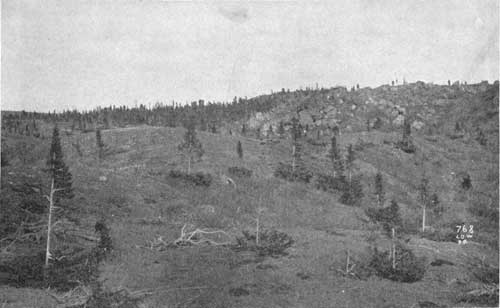
|
|
Plate XI. BLACK SPRUCE ON THE HAMILTON RIVER, LABRADOR, NEAR THE
NORTHERN LIMIT OF TREE GROWTH.
|
THE VARIOUS REQUIREMENTS OF TREES.
Different species of trees, like different races of men, have special
requirements for the things upon which their life depends. Some races,
like the Eskimos, live only in cold regions. (See Pl. XI.) Others, like
the South Sea Islanders, must have a very warm climate to be
comfortable, and are short-lived in any other. (See fig. 23.) So it is
with trees, except that their different needs are even more varied and
distinct. Some of them, like the Willows, Birches, and Spruces of
northern Canada, stand on the boundary of tree growth within the Arctic
Circle. Other species grow only in tropical lands, and can not resist
even the lightest frost. (See Pl. XII.) It is always the highest and
lowest temperature, rather than the average, which decides where a tree
will or will not grow. Thus the average temperature of an island where
it never freezes may be only 60°, while another place, with an
average of 70°, may have occasional frosts. Trees which could not
live at all in the second of these places, on account of the frost,
might flourish in the lower average warmth of the first.
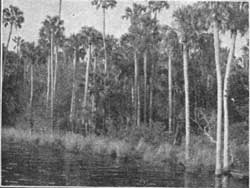
|
|
Fig. 23.—A forest of Palms in southern Florida.
|
In this way the bearing of trees toward heat and cold has a great
deal to do with their distribution over the surface of the whole earth.
Their distribution within shorter distances also often depends largely
upon it. In the United States, for example, the Live Oak does not grow
in Maine, nor the Canoe Birch in Florida. Even the opposite sides of the
same hill may be covered with two different species, because one of them
resists the late and early frosts and the fierce midday heat of summer,
while the other requires the coolness and moisture of the northern
slope. (See fig. 24.) On eastern slopes, where the sun strikes early in
the day, frosts in the spring and fall are far more apt to kill the
young trees, or the blossoms and twigs of older ones, than on those
which face to the west and north, where growth begins later in the
spring, and where rapid thawing, which does more harm than the freezing
itself, is less likely to take place.
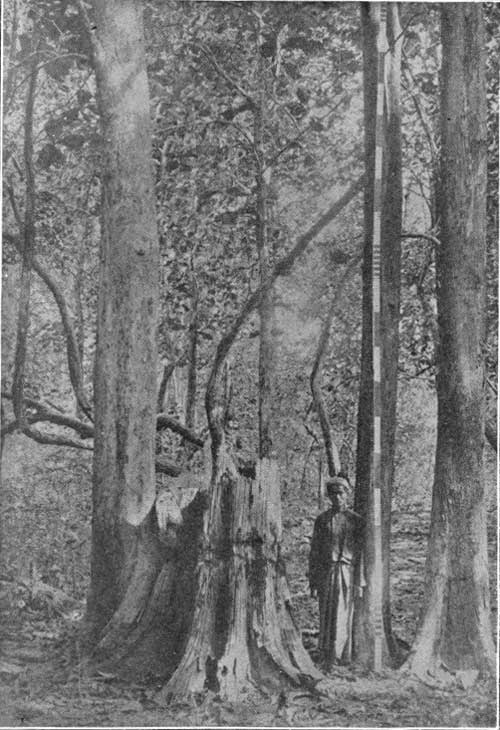
|
Plate XII. A TEAK FOREST IN BRITISH INDIA.
The Teak tree yields one of the most durable and valuable kinds of
timber, especially adapted to shipbuilding, but it will not grow where
there is the slightest frost. Its durability is shown by the condition
of the old stump, from which the large tree on the left grew as a
sprout.
|

|
|
Fig. 27.—Light crown of an intolerant tree, the Western Larch. The
tree with heavy foliage and horizontal branches in the background to the
left is a Western White Pine, a tolerant species. Northern Idaho.
|
REQUIREMENTS OF TREES FOR HEAT AND MOISTURE.
Heat and moisture act together upon trees in such a way that it is
sometimes hard to distinguish their effects. A dry country, or a dry
slope, is apt to be hot as well, while a cool northern slope is almost
always moister than one turned toward the south. Still the results of
the demand of trees for water can usually be distinguished from the
results of their need of warmth, and it is found that moisture has
almost as great an influence on the distribution of trees over the earth
as heat itself. Indeed, within any given region it is apt to be much
more conspicuous, and the smaller the region the more noticeable often
is its effect, because the contrast is more striking. Thus it is
frequently easy to see the difference between the trees in a swamp and
those on a dry hillside near by, when it would be far less easy to
distinguish the general character of the forest which includes both
swamp and hillside from that of another forest at a distance. (See fig.
25.) In many instances the demand for water controls distribution
altogether. For this reason the forests on the opposite sides of
mountain ranges are often composed of entirely different trees. On the
west slope of the Sierra Nevada of California, for example, where there
is plenty of moisture, there is also one of the most beautifull of all
forests. (See fig. 26 and Pl. XIII.) The east slope, on the contrary,
has almost no trees, because its rainfall is very slight, and those
which do grow there are small and stunted in comparison with the giants
on the west. (See Pl. XIV.) Again, certain trees, like the Bald Cypress
and the River Birch, grow only in very moist land; others, like the
Mesquite and the Pinyon or Nut Pine, only on the driest soils; while
still others, like the Red Cedar and the Red Fir, seem to adapt
themselves to almost any degree of moisture, and are found on very wet
and very dry soils alike. In this way the different demands for moisture
often separate the kinds of trees which grow in the bottom of a valley
from those along its slopes, or even those in the gullies of hillsides
from those on the rolling land between. (See Pl. XV.) A mound not more
than a foot above the level of a swamp is often covered with trees
entirely different from those of the wetter lower land about it.
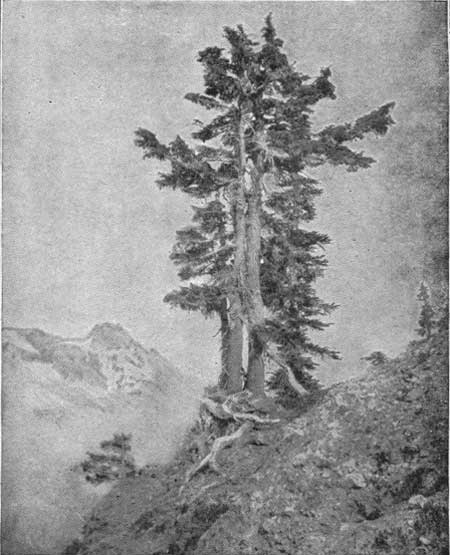
|
|
Fig. 24.—The Black Hemlock in its home. Cascade Mountains of
Washington.
|
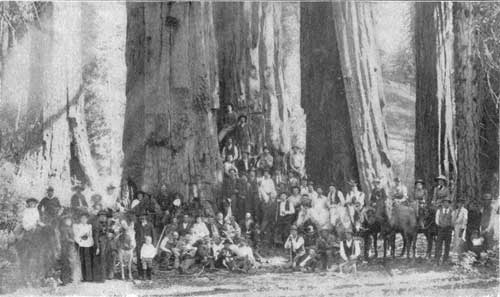
|
|
Plate XIII. FOREST ON THE WESTERN SLOPES OF THE SIERRA NEVADA.
CALIFORNIA. This Sierra forest is one of the richest and most beautiful
of all woodlands. It contains the great Sequoia, massive and imposing
beyond all other trees, and the graceful Sugar Pine, the largest and
among the most useful of Pines. The large trees in the middle of the
picture are Sequoias.
|
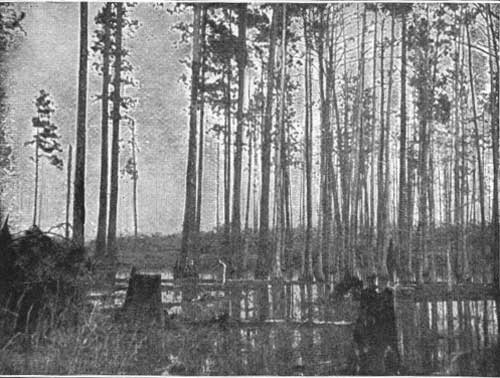
|
|
Fig. 25.—Cypress in a hollow. Pine on the slightly higher land near
by. Wet weather spring, Southern Georgia.
|
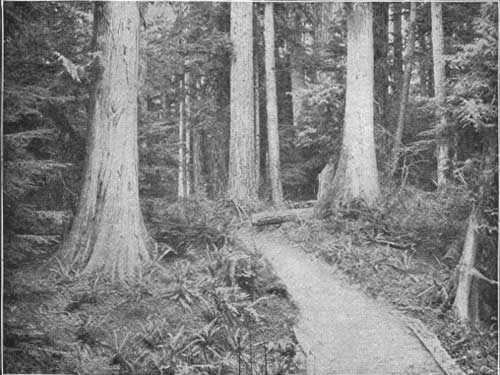
|
|
Fig. 26.—Dense forest in a region of great rainfall. Olympic
Peninsula, Washington.
|
Such matters as these have far more to do with the places in which
different trees grow than the chemical composition of the soil. But its
mechanical nature—that is, whether it is stiff or loose, fine or
coarse in grain, deep or shallow—is very important, because it is
directly connected with heat and moisture and the life of the roots in
the soil.

|
|
Plate XIV. A REGION OF LITTLE RAIN. COLORADO.
|
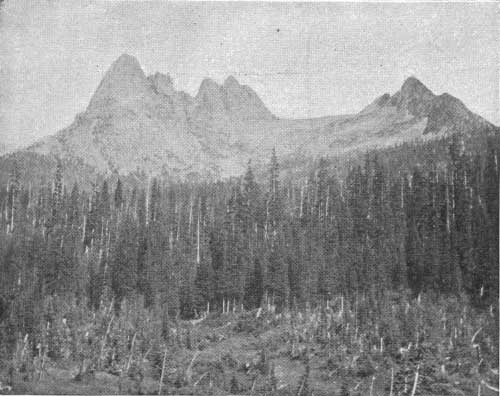
|
|
Fig. 28.—Heavy crowns of a tolerant species. The Alpine Fir in
northern Washington.
|
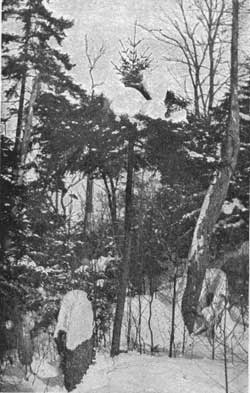
|
|
Fig. 29.—A small Red Spruce in the Adirondack Mountains of New
York. For many years this tree stood under the dense cover of taller
trees. During that time its branches spread to the sides, but it made
scarcely any growth in height. Then more light came to it, probably by
the fall of some tall neighbor, and it began to recover its strength and
grow much faster. The thin upper part of line crown is where this faster
height growth has been going on.
|
REQUIREMENTS OF TREES FOR LIGHT.
The relations of trees to heat and moisture are thus largely
responsible for their distribution upon the great divisions of the
earth's surface, such as continents and mountain ranges, as well as over
the smaller rises and depressions of every region where trees grow. But
while heat and moisture decide where the different kinds of trees can
grow, their influence has comparatively little to do with the struggles
of individuals or species against each other for the actual possession
of the ground. The outcome of these struggles depends less on heat and
moisture than on the possession of certain qualities, among which is the
ability to bear shade. With regard to this power trees are roughly
divided into two classes, often called shade-bearing and
light-demanding, following the German, but better named tolerant and
intolerant of shade. (See figs. 27, 28.) Tolerant trees are those which
flourish under more or less heavy shade in early youth; intolerant trees
are those which demand a comparatively slight cover, or even
unrestricted light. Later in life all trees require much more light than
at first, and usually those of both classes can live to old age only
when they are altogether unshaded from above. But there is always this
difference between them: the leaves of tolerant trees will bear more
shade. Consequently those on the lower and inner parts of the crown are
more vigorous, plentiful, and persistent than is the case with
intolerant trees. Thus the crown of a tolerant tree in the forest is
usually denser and longer than that of one which bears less shade. It is
usually true that the seedlings of trees with dense crowns are able to
flourish under cover, while those of light-crowned trees are intolerant.
This rough general rule is often of use in the study of forests in a new
country, or of trees whose silvicultural character is not known.
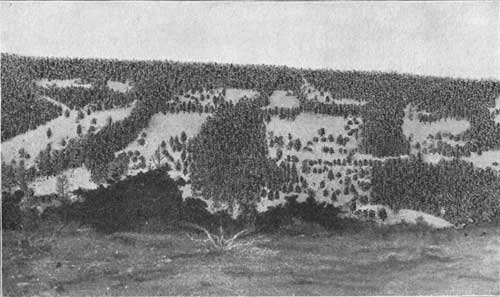
|
|
Plate XV. FOREST-FILLED GULLIES ON THE EAST SLOPE OF THE CASCADE RANGE.
OREGON.
|
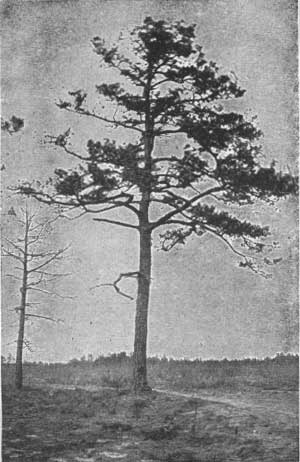
|
|
Fig. 30.—A Pitch Pine, producing seed abundantly, as shown by the
numerous cones, but with no seedlings beneath it. Fire has run over the
ground, and the surface is very dry. A strong breeze was blowing when
the picture was taken. New Jersey.
|
TOLERANCE AND INTOLERANCE.
The tolerance or intolerance of trees is one of their most important
silvicultural characters. Frequently it is the first thing a forester
seeks to learn about them, because what he can safely undertake in the
woods depends so largely upon it. Thus tolerant trees will often grow
vigorously under the shade of light-crowned trees above them, while if
the positions were reversed the latter would speedily die. (See Pl.
XVI.) The proportion of different kinds of trees in a forest often
depends on their tolerance. Thus Hemlock sometimes replaces White Pine
in Pennsylvania, because it can grow beneath the Pine, and so be ready
to fill the opening whenever a Pine dies. But the Pine can not grow
under the Hemlock, and can only take possession of the ground when a
fire or a windfall makes an opening where it can have plenty of light.
Some trees, after being over-shaded, can never recover their vigor when
at last they are set free. Others do recover and grow vigorously even
after many years of starving under heavy shade. The Red Spruce, in the
Adirondacks, has a wonderful power of this kind, and makes a fine tree
after spending the first fifty or even one hundred years of its life in
reaching a diameter of a couple of inches. (See fig. 29.)
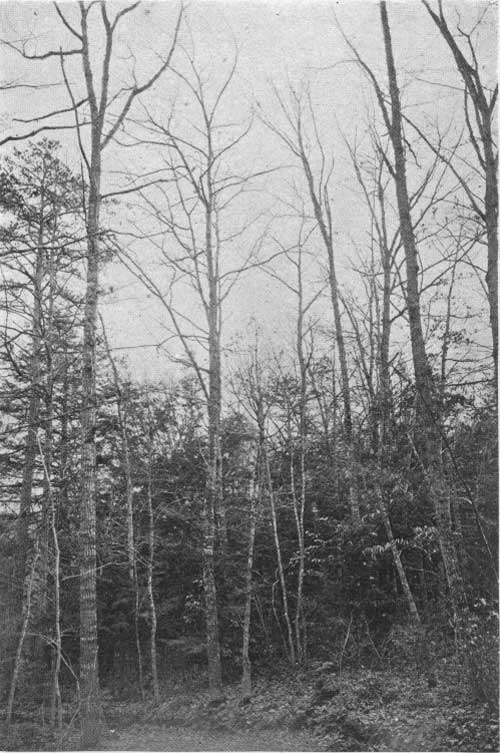
|
|
Plate XVI. A GROUP OF HEMLOCKS AND RHODODENDRONS GROWING IN THE SHADE OF
OAKS AND CHESTNUTS. MILFORD, Pa.
|
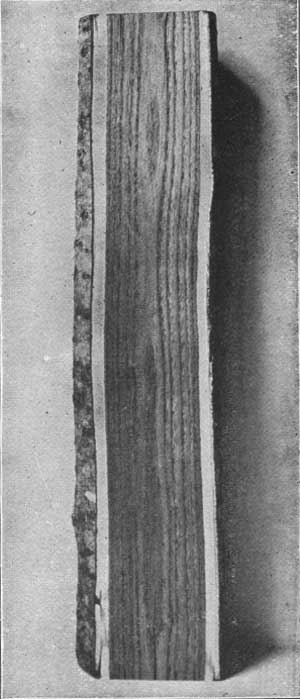
|
|
Fig. 31.—Winged seeds: 1, Basswood; 2, Boxelder; 3, Elm; 4, Fir; 5
to 8, Pine.
|
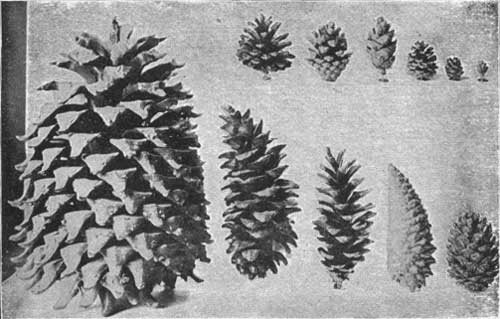
|
|
Fig. 32.—Cones: Beginning at the left, these cones come from
Coulter's Pine, the western White Pine, the Eastern White Pine, the
Knob-Cone Pine, the Fox-Tail Pine, the Pitch Pine, the Lodgepole Pine,
the Red Fir, the Shortleaf Pine, the Eastern Hemlock, and the Eastern
Arbor Vitæ.
|
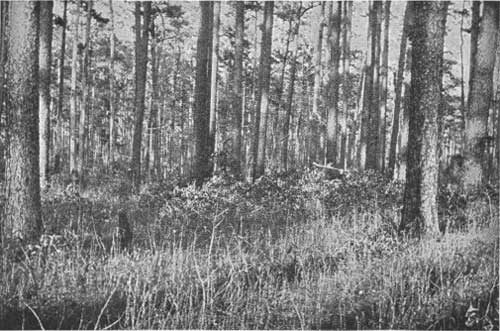
|
|
Fig. 33.—Young Oaks starting under an old forest of Pines. Eastern
North Carolina.
|
The relation of a tree to light changes not only with its age, but
also with the place where it is growing, and with its health. An
intolerant tree will stand more cover where the light is intense than in
a cloudy northern region, and more if it has plenty of water than with a
scanty supply. Vigorous seedlings will get along with less light than
sickly ones. Seedlings of the same species will prosper under heavier
shade if they have always grown under cover than if they have had plenty
of light at first and have been deprived of it afterwards.
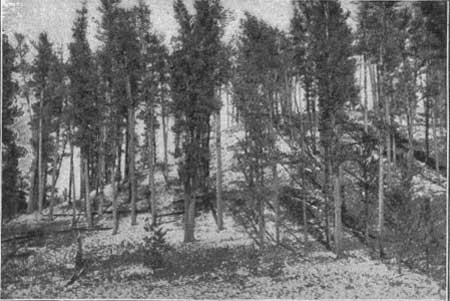
|
|
Fig. 34.—Pure forest of Western Yellow Pine in the Black Hills of
South Dakota. The trees here are smaller in size than those of Montana
(see fig. 35), but their power of reproduction is much greater.
|
THE RATE OF GROWTH.
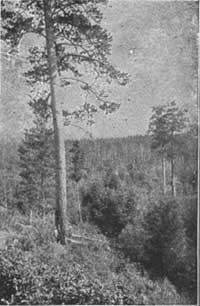
|
|
Fig. 35—Western Yellow Pine in mixture with other trees. Flathead
valley, Montana.
|
The rate of growth of different trees often decides which one will
survive in the forest. For example, if two intolerant kinds of trees
should start together on a burned area or an old field, that one which
grew faster in height would overtop the other and destroy it in the end
by cutting off the light. Some trees, like the Black Walnut, grow
rapidly from their earliest youth. Others grow very slowly for the first
few years. The stem of the Longleaf Pine, at 4 years old, is usually not
more than 5 inches in length. During this time the roots have been
growing instead of the stem. The period of its rapid growth in height
comes later.
The place where a tree stands has a great influence on its rate of
growth. Thus the trees on a hillside are often much smaller than those
of equal age in the rich hollow below, and those on the upper slopes of
a high mountain are commonly starved and stunted in comparison with the
vigorous forest lower down. (See Pl. XVII.) The Western Chinquapin,
which reaches a height of 150 feet in the coast valleys of northern
California, is a mere shrub at high elevations in the Sierra Nevada. The
same thing often appears in passing from the more temperate regions to
the far north. Thus the Canoe Birch, at its northern limit, rises only a
few inches above the ground, while farther south it becomes a tree
sometimes 120 feet in height.

|
|
Plate XVII. STUNTED WHITE-BARK PINE AND BLACK HEMLOCK AT TIMBER LINE ON
MOUNT HOOD. OREGON.
|
THE REPRODUCTIVE POWER OF TREES.
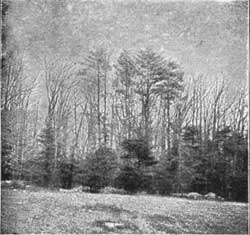
|
|
Fig. 36.—Mixed forest of White Pine, Chestnut, and Oak at Milford,
Pa.
|
Another matter which is of the deepest interest to the forester is
the reproductive power of his trees. Except in the case of sprouts and
other growth fed by old roots, this depends first of all on the quantity
of the seed which each tree bears; but so many other considerations
affect the result that a tree which bears seed abundantly may not
reproduce itself very well. (See fig. 30.) A part of the seed is always
unsound, and sometimes much the larger part, as in the case of the Tulip
Tree. But even a great abundance of sound seed does not always insure
good reproduction. The seeds may not find the right surroundings for
successful germination, or the infant trees may perish for want of
water, light, or suitable soil. Where there is a thick layer of dry
leaves or needles on the ground, seedlings often perish in great numbers
because their delicate rootlets can not reach the fertile soil beneath.
The same thing happens when there is no humus at all and the surface is
hard and dry. The weight of the seed also has a powerful influence on
the character of reproduction. Trees with heavy seeds, like Oaks,
Hickories, and Chestnuts, can sow them only in their own neighborhood,
except when they stand on steep hillsides or on the banks of streams, or
when birds and squirrels carry the nuts and acorns to a distance. (See
Pl. XVIII.) Trees with light, winged seeds, like the Poplars, Birches,
and Pines, have in great advantage over the others, because they can
drop their seeds a long way off. (See figs. 31, 32.) The wind is the
means by which this is brought about, and the adaptation of the seeds
themselves is often very curious and interesting. The wing of a Pine
seed, for example, is so placed that the seed whirls when it falls, in
such a way that it falls very slowly. Thus the wind has time to carry it
away before it can reach the ground. In heavy winds Pine and other
winged seeds are blown long distances—sometimes as much as several
miles. This explains how certain kinds of trees, like the Gray Birch and
the White Pine, grow up in the middle of open pastures, and how others,
such as the Lodgepole Pine, cover great areas, far from the parent
trees, with young growth of even age.
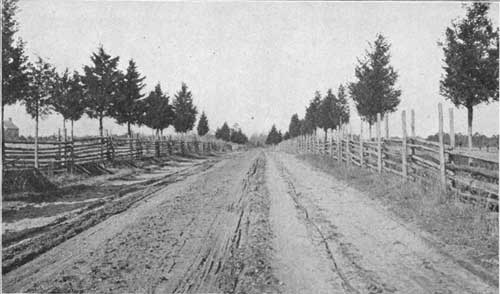
|
|
Plate XVIII. A NATURAL AVENUE OF RED CEDARS. NEW JERSEY. The seeds of
these trees were dropped by birds which perched on the fences.
|
THE SUCCESSION OF FOREST TREES.
Such facts help to explain why, in certain places, it happens that
when Pines are cut down Oaks succeed them, or when Oaks are removed
Pines occupy the ground. It is very often true that young trees of one
kind are already growing unnoticed beneath old trees of another, and so
are ready to replace them whenever the upper story is cut away. (See
fig. 33.)

|
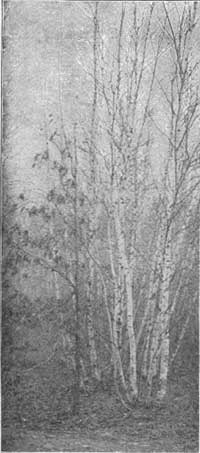
|
|
Fig. 37.—Pure forest of White Cedar near Toms River, New Jersey.
|
Fig. 38.—Sprouts of Gray Birch with a small White Oak in the
foreground. Milford, Pa.
|
PURE AND MIXED FOREST.
The nature of the seed has much to do with the distribution of trees
in pure or mixed forest. It is the habit of some trees to grow in bodies
of some extent containing only a single kind; in other words, in pure
forest. (See fig. 34 and Pl. XIX.) The Longleaf Pine of the South
Atlantic and Gulf States is of this kind, and so is the Lodgepole Pine
of the West. Conifers are more apt to grow in pure forest than broadleaf
trees, because it is more common for them to have winged seeds. The
greater part of the heavy-seeded trees in the United States are
deciduous, and most of the deciduous trees grow in mixed forest,
although there are some conspicuous exceptions. But even in mixed
forests small groups of trees with heavy seeds are common, because the
young trees naturally start up beneath and around the old ones. A heavy
seed, dropping from the top of a tall tree, often strikes the lower
branches in its fall and bounds far outside the circle of the crown.
Trees which are found only, or most often, in pure forest are the social
or gregarious kinds; those which grow in mixture with other trees are
called scattered kinds. Most of the hardwood forests in the United
States are mixed; and many mixed forests, like that in the Adirondacks,
contain both broadleaf trees and conifers. (See fig. 36 and Pls. XX,
XXI.) The line between gregarious and scattered species is not always
well marked, because it often happens that a tree may be gregarious in
one place, and live with many others elsewhere. The Western Yellow Pine,
which forms, on the plateau of central Arizona, perhaps the largest pure
Pine forest of the earth, is frequently found growing with other species
in the mountains, especially in the Sierra Nevada of central California.
(See figs. 34, 35.)
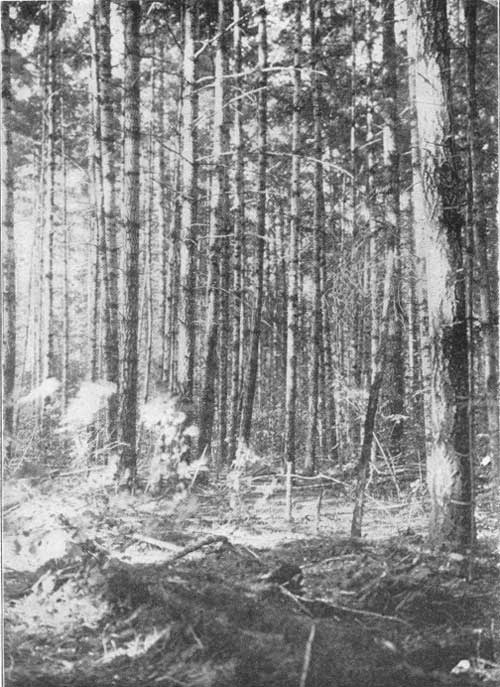
|
|
Plate XIX. PURE FOREST OF YOUNG RED FIR. WESTERN OREGON. Except in parts
of Washington and Oregon, the Red Fir is less often found pure than in
mixture with other tress. It is one of the most valuable timber trees of
the world, and is very widely distributed in the Western States. On the
northern part of the Pacific slope it is very abundant and of great
size, and its wood is widely used both at home and abroad, under the
misleading name of Oregon Pine.
|
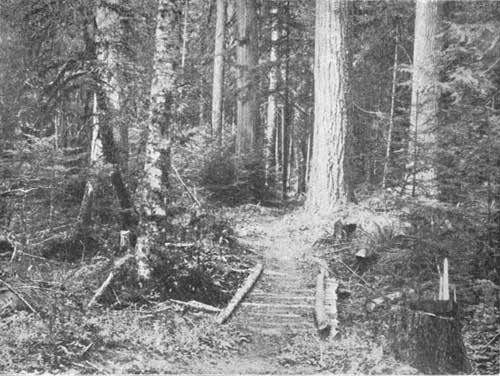
|
|
Plate XX. A MIXED FOREST OF CONIFERS ON THE WESTERN SLOPE OF THE CASCADE
RANGE. VALLEY OF CASCADE CREEK, SKAGIT RIVER BASIN, WASHINGTON.
|
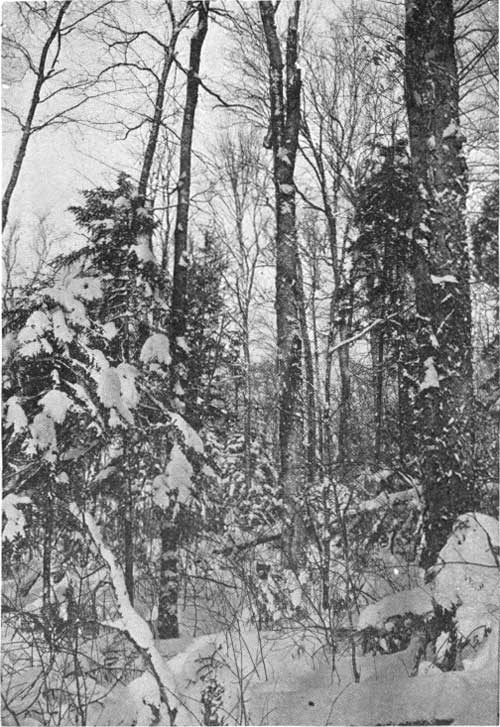
|
|
Plate XXI. MIXED FOREST IN THE ADIRONDACK MOUNTAINS, NEW YORK. A GROUP
OF YOUNG SPRUCES UNDER OLDER SPRUCE, BIRCH, AND MAPLE. In the foreground
are many young broadleaf seedlings. The Adirondack forest contains
Beech, Birch, Maple, Cherry, and Poplar among the broadleaf trees, and
Pine, Spruce, Hemlock, Larch, Fir, and Cedar among the cone bearers.
|
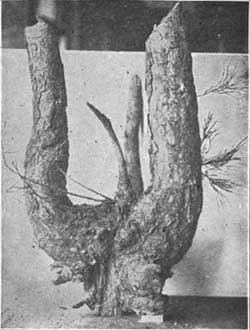
|
|
Fig. 39.—Sprouts of Pitch Pine from the neighborhood of Toms River,
New Jersey.
|
Trees which occupy the ground to the exclusion of all others do so
because they succeed better, under the conditions, than their
competitors. (See fig. 37.) It may be that they are able to get on with
less water, or to grow on poorer soil, their rate of growth or power of
reproduction may be greater, or there may be some other reason why they
are better fitted for their surroundings. But the gregarious trees are
not all alike in their ability to sustain themselves in different
situations, while the differences between some of the mixed-forest
species are very marked indeed. Thus Black Walnut, as a rule, grows only
in rich moist soil, and Beech only in damp situations. Fire Cherry, on
the other hand, is most common on lands which have been devastated by
fire, and the Rock Oak is most often found on dry barren ridges. The
Tupelo or Black Gum and the Red Maple both grow best in swamps, but it
is a common thing to find them also on dry stony soils at a distance
from water. The knowledge of such qualities as these is of great
importance in the management of forest lands.
REPRODUCTION BY SPROUTS.
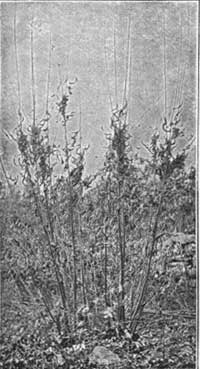
|
|
Fig. 40.—Chestnut sprouts from the stump. Milford, Pa.
|
Besides reproduction from seed, which plays so large a part in the
struggle for the ground, reproduction by sprouts from old roots or
stumps is of great importance in forestry. (See fig. 38.) Trees differ
very much in their power of sprouting. In nearly all conifers except the
California coast Redwood, which has this ability beyond almost every
other tree, it is lacking altogether. The Pitch or Jack Pine of the
Eastern United States has it also to some extent, but in most places the
sprouts usually die in early youth, and seldom make merchantable trees.
(See fig. 39 and Pl. XXII.) In the broadleaf kinds, on the other hand,
it is a general and very valuable quality. Young stumps, as a rule, are
much more productive than old ones, although some prolific species, like
the Chestnut (see fig. 40), sprout plentifully in old age. Other
species, like the Beech, furnish numerous sprouts from young stumps and
very few or none at all from old ones, and still others never sprout
freely even in early youth.
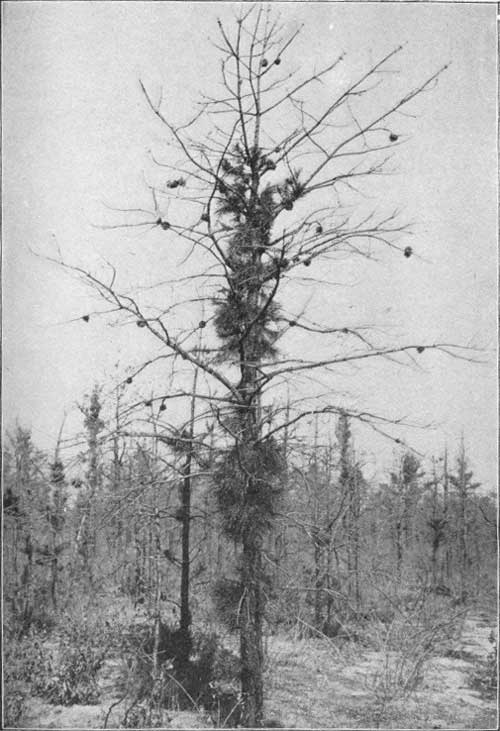
|
|
Plate XXII. SUCKERS, OR SPROUTS, FROM THE TRUNK AND BRANCHES OF A PITCH
PINE. SOUTHERN NEW JERSEY. A year before the picture was taken a forest
fire passed over this place and burned to the top of the tree,
destroying all the needles; yet, the tree was not killed, although
scarcely any other kind could have survived. It put out a vigorous
growth at suckers, and it still has a chance for life. Such examples are
common throughout the burnt parts of southern New Jersey, where large
and vigorous sprouts from the roots of tress of this species which have
keen killed to the ground by fire are very frequent.
|
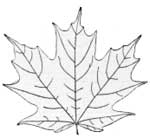
primer/chap2-1.htm
Last Updated: 06-Jul-2009 |
|































